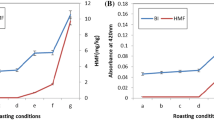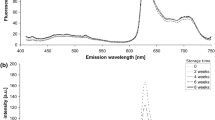Abstract
In the present study, the effects of three production processes (pressing of roasted pumpkin seed paste, pressing of unroasted ground pumpkin seeds and pressing of unroasted ground pumpkin seeds while cooling the press) on the properties of pumpkin seed oils produced from two seed varieties (husked and naked) were investigated. Oils produced with roasting had a higher initial peroxide value (PV), twofold higher total phenol content and better oxidative stability while cold pressed oils had higher tocopherol content. Fatty acid and triacylglycerol compositions were not significantly affected by the processing conditions. Oxidative stability of the oils positively correlated with oleic acid content and negatively correlated with linoleic and linolenic acid contents. The lack of correlation in oxidative stability with tocopherol and polyphenol contents suggests that improvement in oxidative stability of roasted oils could have been caused by antioxidative Maillard reaction products or inactivation of oil degrading enzymes. In addition, oils produced from husked seeds had significantly higher linoleic acid, triacylglycerols (TAG) containing mainly linoleic acid (LLL, OLL and PLL), tocopherol and phenol contents while oleic acid and TAG containing mainly oleic acid (LOO and OOO) contents and oxidative stability were lower. Principal component analysis (PCA) of the analytical data confirmed the observed differences between oils from two varieties and three production processes.


Similar content being viewed by others
References
CODEX STAN (1999) Codex Standard for edible fats and oils not covered by individual standards. FAO/WHO, Rome (CODEX STAN 19-1981)
Narodne Novine (2010) Pravilnik o jestivim uljima i mastima (Regulation on edible oils and fats). Narodne Novine 22/10
Murkovic M, Hillebrand A, Winkler J (1996) Variability of fatty acid content in pumpkin seeds (Cucurbita pepo L.). Eur Food Res Technol 203:216–219
Nederal Nakic S, Rade D, Skevin D, Strucelj D, Mokrovcak Z, Bartolic M (2006) Chemical characteristics of oils from naked and husk seeds of Cucurbita pepo L. Eur J Lipid Sci Tech 108:936–943
Andjelkovic M, Van Camp J, Trawka A, Verhe R (2010) Phenolic compounds and some quality parameters of pumpkin seed oil. Eur J Lipid Sci Tech 112:208–217
Haiyan Z, Bedgood DR, Bishop AG, Prenzler PD, Robards K (2007) Endogenous biophenol fatty acid and volatile profiles of selected oils. Food Chem 100:1544–1551
Tuberoso CIG, Kowalczyk A, Sarritzu E, Cabras P (2007) Determination of antioxidant compounds and antioxidant activity in commercial oilseeds for food use. Food Chem 103:1494–1501
Murkovic M, Piironen V, Lampi AM, Kraushofer T, Sontag G (2004) Changes in chemical composition of pumpkin seeds during the roasting process for production of pumpkin seed oil (Part 1: non-volatile compounds). Food Chem 84:359–365
Siegmund B, Murkovic M (2004) Changes in chemical composition of pumpkin seeds during the roasting process for production of pumpkin seed oil (Part 2: volatile compounds). Food Chem 84:367–374
Lee YC, Oh SW, Chang J, Kim IH (2004) Chemical composition and oxidative stability of safflower oil prepared from safflower seed roasted with different temperatures. Food Chem 84:1–6
Durmaz D, Gökmen V (2010) Changes in oxidative stability, antioxidant capacity and phytochemical composition of Pistacia terebinthus oil with roasting. Food Chem 128:410–414
Vujasinovic V, Djilas S, Diic E, Romanic R, Takaci A (2010) Shelf life of cold-pressed pumpkin (Cucurbita pepo L.) seed oil obtained with a screw press. J Am Oil Chem Soc 87:1497–1505
ISO (2000) Oilseeds—determination of moisture and volatile matter content. International Organization for Standardization, Geneva (ISO 665)
ISO (2006) Oilseed meals—determination of oil content—Part 1: Extraction method with hexane (or light petroleum). International Organization for Standardization, Geneva (ISO 734-1)
ISO (2004) Animal and vegetable oils and fats—determination of acid value and of acidity. International Organization for Standardization, Geneva (ISO 660)
ISO (2007) Animal and vegetable fats and oils—determination of peroxide value—Iodometric (visual) endpoint determination. International Organization for Standardization, Geneva (ISO 3960)
ISO (2000) Animal and vegetable fats and oils—preparation of methyl esters of fatty acids. International Organization for Standardization, Geneva (ISO 5509)
ISO (1990) Animal and vegetable oils and fats—analysis by gas chromatography of methyl esters of fatty acids. International Organization for Standardization, Geneva, (ISO 5508)
AOAC (2000) Triglycerides (by partition numbers) in vegetable oils liquid chromatographic method. AOAC International, Gaithersburg (Official method 993.24)
Butinar B, Bučar-Miklavčič M, Valenčić V, Raspor P (2010) Stereospecific analysis of triacylglycerols as a useful means to evaluate genuineness of pumpkin seed oils: lesson from virgin olive oil analyses. J Agr Food Chem 58:5227–5234
Lísa M, Holčapek M (2008) Triacylglycerols profiling in plant oils important in food industry, dietetics and cosmetics using high-performance liquid chromatography–atmospheric pressure chemical ionization mass spectrometry. J Chromatogr A 1198–1199:115–130
ISO (2006) Animal and vegetable fats and oils—determination of tocopherol and tocotrienol contents by high-performance liquid chromatography. International Organization for Standardization, Geneva (ISO 9936)
Gutfinger T (1981) Polyphenols in olive oils. J Am Oil Chem Soc 58:966–968
AOCS (1992) Oil Stability Index (OSI). American Oil Chemists’ Society, Urbana (AOCS Official Method Cd 12b-92)
Wentzel C (1987) Recent studies on the fatty acid composition of Styrian pumpkin seed oils. Ernährung/Nutrition 11:752–755
Younis YMH, Seniat G, Al-Shihry SS (2000) African Cucurbita pepo L.: properties of seed and variability in fatty acid composition of seed oil. Phytochem 54:71–75
Murkovic M, Pfannhauser W (2000) Stability of pumpkin seed oil. Eur J Lipid Sci Tech 102:607–611
Wada S, Koizumi C (1983) Influence of the position of unsaturated fatty acid esterified glycerol on the oxidation rate of triglyceride. J Am Oil Chem Soc 60:1105–1108
Yoshida H, Tomiyamaa Y, Hirakawaa Y, Mizushina Y (2006) Microwave roasting effects on the oxidative stability of oils and molecular species of triacylglycerols in the kernels of pumpkin (Cucurbita spp.) seeds. J Food Compos Anal 19:330–339
Szydłowska-Czerniak A, Karlovits G, Sosna-Sárdi A, Dianoczki C, Szłyk E (2009) Effect of hydrothermal treatment of rapeseed on antioxidant capacity of the pressed rapeseed oil. J Am Oil Chem Soc 86:817–825
Yoshida H, Tatsumi M, Kajimoto G (1991) Relationship between oxidative stability of vitamin E and production of fatty acids in oils during microwave heating. J Am Oil Chem Soc 68:566–570
Talcott ST, Passeretti S, Duncan CE, Gorbet DW (2005) Polyphenolic content and sensory properties of normal and high oleic acid peanuts. Food Chem 90:379–388
Lee SW, Jeung MK, Park MH, Lee SY, Lee JH (2010) Effects of roasting conditions of sesame seeds on the oxidative stability of pressed oil during thermal oxidation. Food Chem 118:681–685
Gorjanović SZ, Rabrenović B, Novaković M, Dimić EB, Basić ZN, Sužnjević DZ (2011) Cold-pressed pumpkin seed oil antioxidant activity as determined by a DC polarographic assay based on hydrogen peroxide scavenge. J Am Oil Chem Soc doi: 10.1007/s11746-011-1863-3
Szterk A, Roszko M, Sosińska E, Derewiaka D, Lewicki PP (2010) Chemical composition and oxidative stability of selected plant oils. J Am Oil Chem Soc 87:637–645
Gökmen V, Durmaz D (2010) Impacts of roasting oily seeds and nuts on their extracted oils. Lipid Technol 22:179–182
Acknowledgments
The present work is part of the research project “Stability of Oil and Bioactive Compounds in Oil during Processing and Storage” supported by the Ministry of Science, Education and Sports of the Republic of Croatia.
Author information
Authors and Affiliations
Corresponding author
About this article
Cite this article
Neđeral, S., Škevin, D., Kraljić, K. et al. Chemical Composition and Oxidative Stability of Roasted and Cold Pressed Pumpkin Seed Oils. J Am Oil Chem Soc 89, 1763–1770 (2012). https://doi.org/10.1007/s11746-012-2076-0
Received:
Revised:
Accepted:
Published:
Issue Date:
DOI: https://doi.org/10.1007/s11746-012-2076-0




